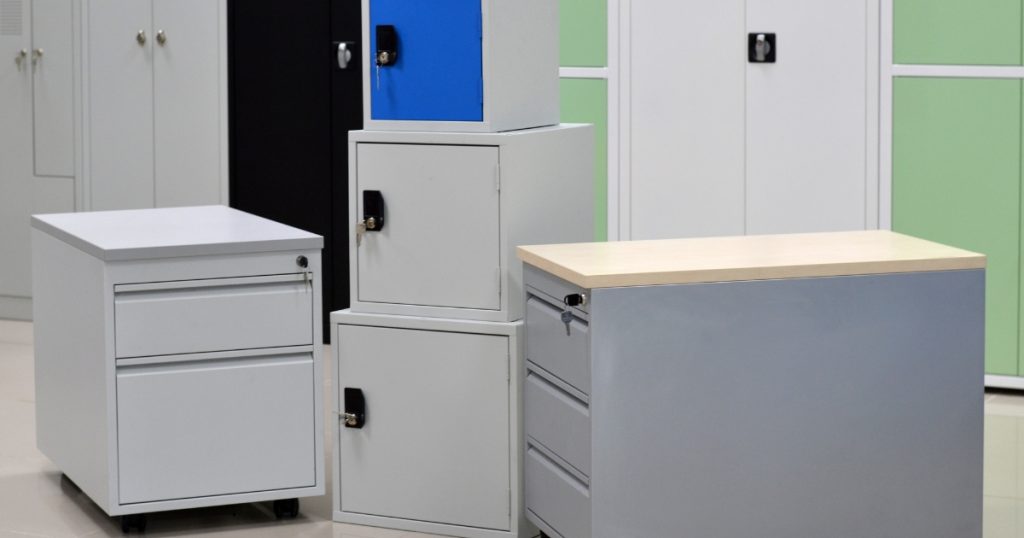When it comes to securing your most important documents, files, and valuables, a file cabinet is an essential piece of office equipment.
However, the security of your file cabinet is only as strong as the lock that keeps it closed. In this article, we’ll explore the various types of file cabinet locks, their advantages and disadvantages, and determine if they are the right choice for your needs.
Types of File Cabinet Locks
There are various types of file cabinet locks on the market, each with its own set of features and benefits. In this section, we’ll explore the most common types of locks, from traditional keyed locks to modern smart locks.
Keyed Locks
Keyed locks are the most traditional and widely used type of lock for file cabinets. These locks are operated by a physical key that is inserted into the lock cylinder and turned to lock or unlock the cabinet. Keyed locks come in two main varieties: cam locks and plunger locks.
Cam locks are found in many file cabinets and feature a rotating cylinder with a cam attached to the end. When the key is turned, the cam rotates, either locking or unlocking the cabinet. Plunger locks, on the other hand, use a push-button mechanism. The key is inserted and turned to release the plunger, allowing the lock to be disengaged.
Advantages:
- Simple and reliable
- Wide variety of key options
- Can be easily replaced or rekeyed
Disadvantages:
- Keys can be lost or copied
- Limited security against lock picking
Combination Locks
Combination locks offer a keyless alternative for securing file cabinets. They use a series of rotating discs or dials that must be aligned in the correct combination to release the locking mechanism. Combination locks come in both mechanical and electronic varieties, with the latter offering additional features such as multiple user codes and audit trail capabilities.
Advantages:
- No keys to lose or copy
- Can be easily reset
- Electronic combination locks offer additional security features
Disadvantages:
- More challenging to operate than keyed locks
- Mechanical combination locks can be more time-consuming to use
Electronic Locks
Electronic locks are a popular choice for modern file cabinets due to their ease of use and advanced security features. These locks use a keypad, card reader, or biometric scanner to authenticate users and grant access to the cabinet. Electronic locks can be programmed with multiple user codes, making them ideal for shared workspaces.
Advantages:
- Enhanced security features
- Multiple user access
- Easy to use and program
Disadvantages:
- Requires a power source (batteries or hardwired)
- More expensive than traditional locks
- Can be vulnerable to hacking or electronic tampering
Smart Locks
Smart locks are the latest advancement in file cabinet security, combining electronic locking technology with wireless connectivity.
These locks can be controlled remotely via a smartphone or computer, allowing users to lock and unlock their file cabinets from anywhere. In addition, smart locks can be integrated with other security systems and provide real-time alerts for unauthorized access attempts.
Advantages:
- Remote access and control
- Integration with other security systems
- Real-time alerts and monitoring
Disadvantages:
- Requires a stable internet connection
- More expensive than other lock types
- Potential vulnerability to hacking or cyber-attacks
Factors to Consider When Choosing a File Cabinet Lock
Before deciding on the best lock for your file cabinet, it’s important to consider several factors, including the level of security you require, ease of use, price, and installation and maintenance requirements.
Security Level
The level of security provided by a file cabinet lock is one of the most important factors to consider. Keyed locks provide basic security but may be more susceptible to picking or unauthorized key duplication.
Combination locks, electronic locks, and smart locks offer increased security features, such as unique user codes and audit trails, which can deter unauthorized access.
Ease of Use
Another important factor to consider is the ease of use of the lock. Keyed locks are generally the simplest to operate, while combination and electronic locks may require additional steps to enter codes or authenticate users.
Smart locks offer the convenience of remote access and control but may require additional setup and ongoing maintenance.
Price
Price is always a consideration when selecting a file cabinet lock. Traditional keyed locks are generally the most affordable option, while electronic and smart locks tend to be more expensive due to their advanced features.
It’s important to weigh the cost of the lock against the value of the items being secured and the level of security you require.
Installation and Maintenance
Consider the installation and maintenance requirements of the lock you choose. Some locks, such as keyed locks and mechanical combination locks, can be easily installed by most users, while electronic and smart locks may require professional installation.
In addition, electronic and smart locks may have ongoing maintenance requirements, such as battery replacement or software updates.
Alternatives to Traditional File Cabinet Locks
While file cabinet locks are an effective way to secure your important documents and valuables, there are alternatives to consider if you’re looking for additional security or storage options.
Security Safes
Security safes offer an added layer of protection for your most valuable items, such as passports, cash, and jewellery. Safes come in various sizes and can be equipped with different types of locks, including key, combination, electronic, and biometric.
Some safes are also fireproof and water-resistant, providing extra protection against damage or loss.
Secure Storage Facilities
If you have a large number of important documents or items that require secure storage, you may want to consider renting a unit at a secure storage facility. These facilities typically offer 24-hour surveillance, gated access, and climate-controlled units, providing a safe and secure environment for your belongings.
Cloud Storage
For digital documents and files, cloud storage services offer a convenient and secure alternative to physical file cabinets. Cloud storage allows you to store your files remotely on secure servers, which can be accessed from anywhere with an internet connection.
Many cloud storage providers offer encryption and other security features to protect your data from unauthorized access.
Frequently Asked Questions About File Cabinet Locks
Can I replace the lock on my existing file cabinet?
Yes, most file cabinet locks can be easily replaced or upgraded. Consult your cabinet manufacturer or a locksmith for advice on the best replacement lock for your specific cabinet.
Can I install a file cabinet lock myself?
Some types of file cabinet locks, such as keyed locks and mechanical combination locks, can be installed by most users with basic DIY skills. However, electronic and smart locks may require professional installation due to their complexity and potential electrical wiring requirements.
What should I do if I lose the key to my file cabinet lock?
If you lose the key to your file cabinet lock, contact a local locksmith who can either create a new key or replace the lock. Some lock manufacturers may also be able to provide replacement keys if you can provide proof of purchase and the lock’s serial number.
How can I prevent unauthorized access to my file cabinet?
Choose a lock that provides an appropriate level of security for your needs, and ensure that keys, combinations, and access codes are kept secure and only shared with authorized users. Regularly update access codes and consider upgrading to a more secure lock if needed.
Can file cabinet locks be easily picked?
While some low-quality keyed locks may be susceptible to picking, high-quality locks, combination locks, electronic locks, and smart locks are generally more resistant to unauthorized access. To further deter lock picking, consider choosing a lock with additional security features such as anti-pick pins or a restricted keyway.
Conclusion
File cabinet locks are an essential component of securing your important documents, files, and valuables.
With various lock types available, including keyed locks, combination locks, electronic locks, and smart locks, it’s crucial to consider factors such as security level, ease of use, price, and installation and maintenance requirements when choosing the right lock for your needs.
While file cabinet locks can provide a strong level of security, it’s also worth considering alternatives such as security safes, secure storage facilities, and cloud storage for added protection or additional storage options.
By carefully assessing your unique requirements and exploring the various file cabinet lock options available, you can ensure that your important documents and valuables are kept secure and accessible only to authorized users.

